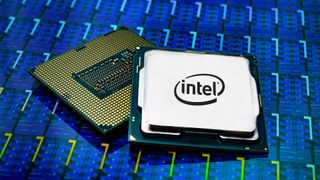Intel is using two manufacturing processes for some Comet Lake Core i5 CPUs
Some 10th Gen Intel Core i5 processors were born from bigger chips.

Some Intel Comet Lake Core i5 processors are not like the others, meaning the silicon beneath the heat spreader can be a little different chip-to-chip. The Intel Core i5 10400 and Core i5 10400F are both available with one of two steppings, either Q0 or G1, and these signal whether these chips are a native six-core or a cut-down 10-core chip.
This isn't something to worry about with the Core i5 10600K, however, as the top-end i5 is running on the same Q0 10-core die as the flagship Core i9 10900K CPU, but with four cores shut down. Though it's also unlikely to be something to worry about with a non-overclocking CPU anyway.
We first heard about the multiple steppings over at TechPowerUp, and we immediately reached out to Intel to double-check. We were told "the Core i5-10400 and Core i5-10400F use two manufacturing processes," and that it's all posted over at Intel ARK within the Ordering and Compliance section for each chip.
Lo and behold, it's all in there. Almost every detail is identical between the two steppings, including clock speed and pricing, so we don't suspect there'll be any mad rush to get one or the other. Reports suggest the thermal solution used on the Q0 stepping will fall in line with the enthusiast-grade 10th Gen processors—i.e. thinner dies and soldered interface material—as it is said to be a 10-core chip with four cores disabled.
That could make for better thermal performance, and perhaps offer a boon for mobo manufacturers' recent power limit semi-overclocking. Although we don't imagine it would affect all that much at stock with any half-decent cooler.
The G1 stepping, however, is said to be a native six-core chip. This is reportedly using a thermal paste, rather than the new STIM solution. Nevertheless, when we're talking about non-K, non-overclockable, processors, that shouldn't prove a hindrance to the performance of the G1 processor.
The easiest way to discern the two steppings, if you have them to hand, is to take a look at the reverse of the chip. The Q0 stepping has two clearly separated groups of capacitors, while G1 is more or less a single block. The two also have differing spec codes, as evidenced over in ARK.
The biggest gaming news, reviews and hardware deals
Keep up to date with the most important stories and the best deals, as picked by the PC Gamer team.
So, as it turns out, there's not much to see here. But it remains a fascinating glimpse into the chipmaking process and how Intel's going about binning its 14nm processors now that it's reaching lofty core counts, such as with the 10-core i9 10900K.
The Intel Core i5 10400, with a compliment of six-cores, appears to be a solid buy for affordable gaming performance, and we're keen to take a look to find out if it can compete for a spot in our best gaming CPU guide.

Jacob earned his first byline writing for his own tech blog. From there, he graduated to professionally breaking things as hardware writer at PCGamesN, and would go on to run the team as hardware editor. He joined PC Gamer's top staff as senior hardware editor before becoming managing editor of the hardware team, and you'll now find him reporting on the latest developments in the technology and gaming industries and testing the newest PC components.
Most Popular





